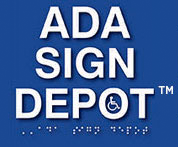Living in Between the Deaf and Hearing Worlds
ADA Sign Depot
March 09, 2016

Between the Deaf and Hearing Worlds
Source: The Atlantic
by Jessica Jafet
With cochlear implants, people can turn the noise around them on and off at will.
A Student Wearing a Cochlear Implant – Photo by Eckehard Schulz / AP
He received his first cochlear implant when he was a year old. Now in middle school, he’s spent almost his whole life with the ability to turn off the world’s noise at will. In the morning, he attaches the external magnets of his cochlear implants to each side of his head, where they transmit sound from the microphones and speech processors worn over his ears. The electrode arrays in each of his cochleae then stimulate the auditory nerve, and zap, he “hears.”
With his implant, he’s become part of a new generation of profoundly deaf kids who are assimilated into the mainstream hearing world. In 1989, the Food and Drug Administration approved cochlear implants for children aged 2 years or older; in 2000, the agency green-lit implants for kids as young as 12 months. In the wake of those approvals, thousands of parents like me—with no connection to Deaf culture or knowledge of American Sign Language—have opted to have their children receive implants. (More than 90 percent of congenitally deaf babies are born to typical-hearing parents.)
But our decision also placed our son in between two worlds: He is not a member of deaf signing culture, but neither is he fully part of the hearing community. Instead, he lives somewhere in the middle, joining the 48 million Americans who are challenged with some level of hearing loss.
“Sometimes my brain accounts for the fact that I don’t hear,” he says. “Like if I stomp my foot with my implants off, then my brain kind of makes a sound for it.” He is coming to recognize himself as a “hearing/deaf” person—an identity that has shaped his sense of social inclusion in unique ways. When his cochlear implants are off, he says, he experiences the world through a kind of “peaceful darkness.” (At times, the decision to turn it on and off is a strategic one: “It is kind of cool to take them off when someone is being annoying to me.”)
According to the FDA, approximately 88,000 people in the U.S. had received cochlear implants as of 2012, including around 38,000 children. The majority of these children attend schools alongside typical-hearing peers, which can be mentally and emotionally taxing as they work to keep up with the sounds around them.
“It’s not like you put [the implants] on and you can hear just like a normal person,” he reminds me. “Sometimes words just get all mixed up and you just can’t understand the person.” Indeed, experts in field of auditory-verbal therapy stress that implant-wearers must be “hearing athletes” in order to thrive in the cacophonous world. Listening is not a passive endeavor, and pressure to keep up can be tiring.
In recent years, advancements in hearing technology have made it a little bit easier. My son now has the Naida CI Q90, a model from the California-based implant manufacturer Advanced Bionics. The implant, recently approved by the FDA, contains software that more effectively minimizes echo, wind, and reverberation sounds. It has Bluetooth capability, meaning that music, movies, and phone calls can be sent wirelessly into his device. It’s also capable of zooming in on a single voice in a noisy environment.
The implant has gone a long way towards helping him integrate more seamlessly into the everyday hearing world. At school, for example, the teacher’s voice is transmitted to our son’s receivers via an FM system above all other sound, and a portable pen-shaped microphone on his school desk picks up small group conversations.
But for a tween, naturally, the biggest concern it is all about fitting in. My son’s hair is now deliberately long enough to cover his hearing devices. When asked how he enjoys music, he says that he likes the feeling of hearing what his friends are listening to.
“Maybe I’m not even hearing the same things as them because I have no idea how people hear,” he says, “but I have the feeling I’m really close to it.”
Shop all our Handicapped Parking ADA Signs
- Tags: ADA People Subscribe to this blog's RSS feed.


